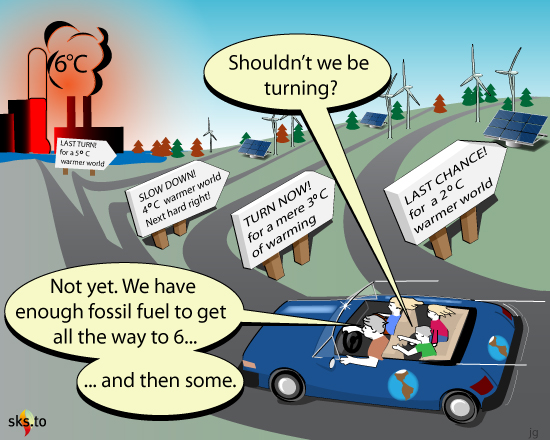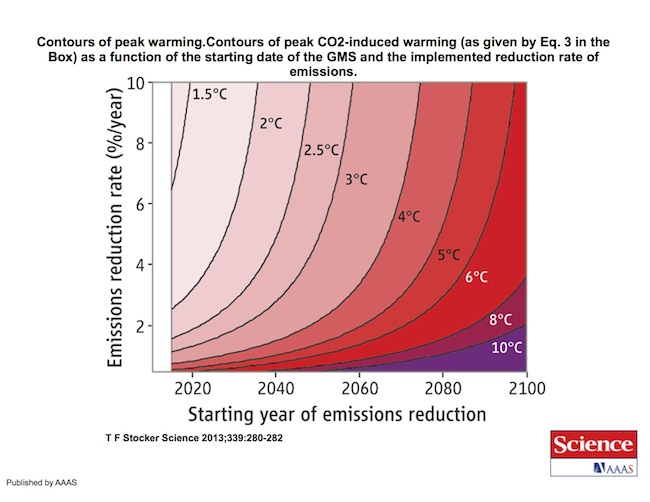Forks in the Road: Last Exit to Two Degrees
Posted on 30 April 2013 by Sarah
'Would you tell me, please, which way I ought to go from here?'
'That depends a good deal on where you want to get to,' said the Cat.
'I don't much care where —' said Alice.
'Then it doesn't matter which way you go,' said the Cat--
The road we are on leads to a climate hotter than any humans have yet endured. Only by cutting carbon emissions can we steer toward a stable climate. Each day that we don’t choose the path of reduced carbon emissions we cut off a possible climate endpoint. And the longer we delay turning down the path carbon-free energy the sharper and more difficult the turn will be.
Image by John Garrett, 2013.
The countries of the world have agreed that the place we want to go is not more than 2 degrees C warmer than our historical climate. But the road we are on takes us to a planet that is 5 °C hotter, also known as Hell. We can decide to change direction at any point along our current path and head instead toward the planet we want to live on. But the further we go down this track before changing course the more abruptly will we have to turn to reach our destination. And if we ignore all the roadsigns and warnings we will overshoot the target. Backtracking is impossible; the climate can't turn on a dime.
A critical and misunderstood fact is that the road to our future climate is a one-way street. Emissions today determine tomorrow’s climate. It will do no good in ten years to wish we had changed directions back in 2010. U-turns are impossible.
Dr. Thomas Stocker of the University of Bern recently provided a helpful roadmap that tells us how fast we’ll have to go and how sharply we must turn based on the year we decide to change course [1].
He charts our possible routes by using the fact that the three factors are interrelated: how fast we switch to zero-carbon energy and the date we commit to start the conversion determine our ultimate global temperature. The final global temperature is tied very closely to the total amount of carbon dioxide that humans add to the atmosphere, including the 568 GtC we already added. This budget approach is a nice way to simplify the many emission numbers we see. One trillion tonnes emitted means a final temperature of 2 °C hotter. (One Gigatonne of carbon, GtC is a billion tonnes; one trillion tonnes is a Teratonne, TtC, equivalent to 1000 GtC.)
Stocker projects the climate we’ll get based on when and how fast we decrease carbon emissions. For each case he assumes that once we commit to change we will gradually reduce emissions by a fixed percentage each year until we reach a carbon neutral economy, that is, zero carbon emissions. His scenarios are deliberately simplified to get a bird’s eye view of the route options.
Contours of peak warming. Contours of peak CO2-induced warming (as given by Eq. 3 in Stoker [1]) as a function of the starting date of a Global Mitigation Scheme (GMS) and the implemented reduction rate of emissions. The later the GMS starts, the higher the required emissions reduction rate is for a given peak warming [2].
Figure from T. F. Stocker, Science 2013, 339, 280–282. doi: 10.1126/science.1232468. Reprinted with permission from AAAS.[3]
To read this graph select the year reductions of global carbon emissions will start on the x-axis and how fast they will decrease on the y-axis. The intersection point tells the peak temperature that we’ll get [2]. (See the original paper for the equations [1].)
For example, if we start immediately in 2013 reducing global carbon emissions by 2.5% per year we can still reach a peak temperature rise of 2°C. If we don't start until 2020, cuts will have to be 3.2% per year to get to the same endpoint. If we wait until 2032 cuts would have to be twice as large: 6.4% per year. And remember that is 6.4% per year every year until we reach zero carbon emitted per year. Although the graph shows 10% reduction rates, cuts of more than 5% per year are considered to be economically very unfeasible.
Where are we now?
The site trillionthtonne reports cumulative global carbon emissions from human activities. Today (April 2013) we've reached 568.9 Gigatonnes and the site predicts we'll reach one trillion tonnes in 2041. If we wait until 2041, we'd have to cut emissions to zero instantaneously, essentially a U-turn at full speed, to reach the 2 °C target. The figure shows this is truly the critical decade if we want to stay under 2 °C without an economically drastic whiplash of 5% decrease in emission per year.
Global emissions increased by 3% in 2011 [4] and show no sign of slowing. In order to reach our 2 °C target, emissions must decrease by 3% per year starting in 2020. If emissions don’t start going down dramatically by 2027, the 2°C goal will be impossible. The longer we wait the hotter we’ll get. And the faster we’ll have to run to get where we want to go.
We stand now where two roads diverge. But unlike the roads in Robert Frost's familiar poem, they are not equally fair. The road we have long been traveling is deceptively easy, a smooth superhighway on which we progress with great speed, but at its end lies disaster. The other fork of the road — the one less traveled by — offers our last, our only chance to reach a destination that assures the preservation of the Earth. - Rachel Carson
References
[1] T. F. Stocker, Science 2013, 339, 280–282. doi: 10.1126/science.1232468.































 Arguments
Arguments
































Curiously, a few years back Canadian expatriate writer Gwynne Dyer wrote a column along a similar vein, called "Last Exit to the Holocene".
Bottom line, then and now: if you want to live in the more-or-less stable climate which enabled human agriculture (and hence the comfortable, materially affluent civilization I daresay most of us prefer to live in), time to get cutting down on emissions.
I have to say, that cartoon by John Garrett is pretty awesome. Well done.
Stop the world, please - I want to get off before it crashes ...
The only way I can see that the necessary measures will be taken is if America adopts representative government such as we have in New Zealand. Since this would shaft most of the congress and senate, there is zero chance that it will happen. Right from it's inception, the government of the USA has been corrupt, looking after vested interests instead of the good of it's citizens and warring on other countries to steal their resources and nothing has changed. Our only hope is that so many states, cities, businesses and private people in the states are doing what is necessary. The American people are great, their government, not. Remember Ike's warning.
We need to look very carefully at the contribution of the other GGs, and in this connection I note that T.J.Blasing ( CDIAC, Recent Greenhouse Gas Concentrations, updated Feb 2013) calculates a combined 1.04 Watts per square meter of increased radiative forcing from CH4, N2O and O3, plus a small 0.34 from the others. That totals to 1.384 W/m, surely not an insignificant addition to the increased radiative forcing of 1.85W/m from CO2 alone. Butler (the NOAA Annual Greenhouse Gas Index 2012) calculates a CO2 equivalent of 473 ppmv for 2011. And that, with all the uncertainties, says to me that we have already, very probably, jumped the 2 degree barrier.